Kisu

 back view, copyright gae savannah 2006
back view, copyright gae savannah 2006Labels: click to enlarge
Shasta, Nyassa Dam,Stuhltrager gallery view
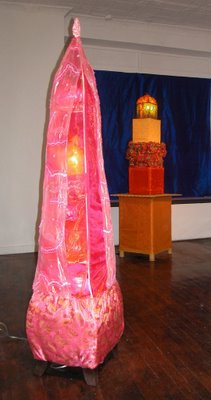

Labels: copyright gae savannah 2006
A Fool and His Froth are Soon Parted statement
“A Fool and his Froth are Soon Parted” Gae Savannah 2006
In polytheistic psychology’s circularity of topoi there seem to be no preferred positions, no sure statements about positive and negative and therefore no need to rule out some configurations and topoi as pathological;. …hence there can be more tolerance for the non-growth, non-upward, and non-ordered components of the psyche. James Hillman Blue Fire
The folly of subterranean emotional life, the sublimely ridiculous, mystical dreaming…--more intrigued by the ‘uncool,’ I’m not interested in making shrewd or prosaic things. Complexities of muddled emotions, narcissism, self-sabotage, self-delusion, stupor and intoxication attract me. Dostoevsky’s Fyodor Pavlovich abjectly refuses to reign in his perverse whims, propensity to provoke. (Brothers Karamazov). Self-declared buffoon, he will not be denied the titillation of pulling the rug out from under any sanctified rite of decorum. Mortifying all present, he can’t resist lampooning Catholic hypocrisy during a ceremonial family meeting with a top church elder. In Notes from the Underground, our needy narrator hounds a disdaining socialite to procure an invitation to a party. The day arriving, the narrator further demeans himself by turning up two hours early with desperation on his sleeve. Fitzgerald’s Beautiful and Damned Anthony Patch adopts irony and vacillates between self-effacement and aggrandizement all in the first paragraph.
I aim to traverse the murky depths of the subconscious, eluding the blandness of the conventional art world and vacuity of newest skateboard chic. It was ‘Lunatic’ Parsifal who asked the obvious question.
In River Town, Peter Hessler muses:
“(‘I dislike Hamlet’s hesitation. As a man he should do what he wants to do resolutely.’ student’s journal, Fuling China)
You couldn’t have said something like that at Oxford. You couldn’t simply say I don’t like Hamlet because I think he’s a lousy person. Everything had to be more clever than that; you had to recognize Hamlet as a character in a text, and then you had to dismantle it accordingly, layer by layer, not just the play itself but everything that had ever been written about it. You had to consider what all the other critics had said, and the accumulated weight of their knowledge and nonsense sat heavily on the play. You had to think about how the play tied in with current events and trends. This process had some value, of course, but for many readers it seemed to have reached the point where there wasn’t even a split-second break before the sophistication started. As a student, that was all I had wanted –-a brief moment when a simple and true thought flashed across my mind: ‘I don’t like this character. This is a good story.’ This was what I was looking for as a student—some sign that literature was still enjoyable, that people read for pleasure and that this was important in and of itself, apart from the politics…In Fuling there was no question that the students enjoyed what they read… Sometimes when they were working on an assignment, and I was looking out at the Wu River, I’d smile and think to myself: We’re all refugees here. They’ve escaped from their classes on building Chinese socialism, and I’ve escaped from deconstructionism.”
In buying hand-crafted Chinese furniture, baskets hand-woven on the islands of Cebu, Philippines, and silk hand-beaded in India to fold glibly into contemporary sculpture, I brandish American, suburban hubris. Craft/folk art is always an underpinning. Can I buy heart? In the global Capitalist paradigm, the 'fool' is the indigent craft laborer, forging exquisite colored glass lanterns in Morocco for quarters. Comically blanketing an old wooden Chinese footstool in plastic plaid hair clips epitomizes the foolishness of America. (plaid invokes our imperialistic lineage, England and its vanquished.)
The fool is l. I am like Bartelby. I refuse to edit and calculate my actions (artwork) according to what is acceptable social code. I prefer not to manufacture cold, sanitized, cerebral, sparse, snide, or hackneyed rectangles to sell to lemmings, collectors of the insipid familiar. (A new Korean SVA MFA student queried, “Gae where do they show the sculpture in Chelsea?” …Uhhh ...) I make eclectic, overdressed, queer entities. What a fool am I to pour obscene amounts of labor into un-beige-enough-for-the-living-room-wall ‘amphigory.’ A fool can’t resist sap, sentimentality. Ever indulging in the one-step-too-far foppish, I can’t resist adding wings to sculptures. Like a shameless dog, I have no dignity. Like Coetzee in Disgrace, ultimately, I rest my case on the intrinsic right to desire.
“The pleasure of the text is not necessarily of a triumphant, heroic, muscular type. No need to throw out one’s chest. My pleasure can very well take the form of a drift. Drifting occurs whenever, by dint of seeming driven about by language’s illusion, deductions, and intimidations like a cork on the waves, I remain motionless, pivoting on the intractable bliss that binds me to the text (to the world). Drifting occurs whenever social language, the sociolect, fails me…Thus another name for drifting would be: the Intractable—or perhaps even: Stupidity.”
(Roland Barthes,
the Pleasure of the Text.)
 © Gae Savannah"KHi KHi" 2005; fabric, hair accessories, beads, fountain, wood, light, 33” x 33” x 44”
© Gae Savannah"KHi KHi" 2005; fabric, hair accessories, beads, fountain, wood, light, 33” x 33” x 44” 
Labels: copyright gae savannah 2006
Lei-tsu
 © Gae Savannah"Leitsu" 2003; (purple) hair accessories, Christmas ornaments, beads, feathers, wire, wood; 22” x 9” (diameter)
© Gae Savannah"Leitsu" 2003; (purple) hair accessories, Christmas ornaments, beads, feathers, wire, wood; 22” x 9” (diameter) 
Labels: copyright gae savannah 2006
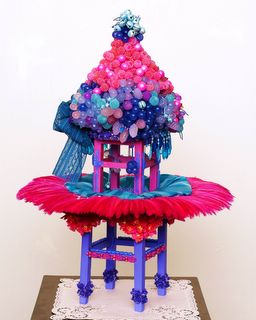 © Gae Savannah"Gala" 2003; hair accessories and mixed media, 19” x 13” (diameter)
© Gae Savannah"Gala" 2003; hair accessories and mixed media, 19” x 13” (diameter) 
Labels: copyright gae savannah 2006
FOLLY, FEMININITY A MUSING…
Fatuous footstools –femininity as confection, cream puff, cupcake, tartlette…Kim Novak, (the Amorous Adventures of Moll Flanders;) Lisa Kudrow, (Romi and Michele’s High School Reunion;) Caroline, dress-up duchess, (Anita Brookner’s novel, Providence;) Hyacynth (British TV’s Keeping Up Appearances;) the narrator’s (mis)calculating mom of purple hat debacle, (Flannery O’Connor’s Everything That Rises Must Converge;) and…
Footstools and Vanity Benches explores both intrinsic and fabricated femininity. Invoking “low art,” (read: “girl art’) --crafts, interior design, and fashion, I use fabric, hair accessories, beads, and Christmas and floral fare to debunk the value system of Fine Art where frivolity is still the poor cousin to austerity. Although undervalued, frivolity is not vacuous, but teeming with insight about our interior emotional life. Like itsy-bitsy, supra-beribboned doggies on Madison Avenue Manhattan, the benches are prim, preened, and poofed coquettes or wannabe princesses. The patterns --powder blue, French boudoir toile, striped Indian Shantung silk, and chartreuse Chinese silk brocade --make drawing room or bedroom culture palpable. All in all, spruced up, poised to please, both fetching and ungainly characters stir up the visceral desires of the beholder.
Like those of materials, twists of language, can divulge the paradoxical nature of what we deem “profound” or “superficial.” In Thomas Mann’s Death in Venice, it is frills that spawn lucid, cogent prose. “Glamour” originated in a Scottish corruption of the term “grammar.” “Narmada,” the holiest river in India, means “whore.” “Cosmetics” and “cosmos” notwithstanding, harkened from the same French root, and on Keats’ Grecian Urn, prettified is even “petrified.”
“Maja,” one piece’s title, is derived from Maya, the Hindu goddess of material appearances. Maya personifies the central philosophical concept of Hinduism --that the physical world, although intoxicating in its multiplicity and diversion, is actually a veil of illusion. To Hindus, beneath what our senses tell us, there is a sustaining spiritual foundation. But in America, foundation is manufactured by Cover Girl. To attain the revered “flawless finish,” our goddess is not Maya but Maja, powder and perfume with a hackneyed Spanish flamenco dancer logo sold in cheap variety stores in Queens.
Fabric can be defined as both an internal framework, as in the fabric of society and as an external covering. Like veils which both conceal or accentuate, appearances not only lie but also tell the truth.
 © Gae Savannah with Dae Seung Seo "Meraharem HP1" 2001; C-print and performance/installation, 18” x 24"
© Gae Savannah with Dae Seung Seo "Meraharem HP1" 2001; C-print and performance/installation, 18” x 24"
Labels: copyright gae savannah 2006
Meraharem JP6
 © Gae Savannah with Dae Seung Seo"Meraharem JP6" 2001; C-print and performance/installation, 18” x 24"
© Gae Savannah with Dae Seung Seo"Meraharem JP6" 2001; C-print and performance/installation, 18” x 24"Labels: copyright gae savannah 2006
Meraharem statement
We need only realize how much obsessed a person is not only with the desired one but with desire itself; how (s)he is not seeking sainity but intoxication and yearning, and fears nothing more than to be relieved of his her delusion.
Thomas Mann, The Transposed Heads
In Harem, The World Behind the Veil, A.L. Croutier states: "The harem is a unique archetype of the collective unconscious. ‑‑where there are 1001 chambers of our dreams." Maraharem with striped silks and diaphanous veils is a netherworld where time is suspended and the sensuous reigns.
In skewing rigid notions of gender, we aim to recast femininity as a safe, challenging realm for men. Here men are drawn into the intoxicating and confusing experience of being looked at, where power is derived passively. All the same, while female viewers become navigators of the gaze, the point is not a reversal of power.
Instead, through art, a shared reciprocity between genders, and more expansive self‑expression beyond prescribed gender roles, can evolve. Ultimately situated perhaps on the bank of the Mediterranean Sea in Turkey or in a country in one's mind, this feminine lair manifests an insatiable longing for the exotic other. Although intellectualism is presently viewed as the peak of human potential, we would argue that one's desires form the core of human existence. Indeed here, all elements are subordinated to the delirium of the emotions. As in Hollywood simulacra where authenticity of cultural details is irrelevant, Meraharem is a pastiche of divergent Eastern objects, characters and patterns.
The photos recall sensationalized Indian kitsch of multi‑limbed magical Hindu goddesses and gods in too much make‑up and gaudy tunics. And yet all told, the frivolity and sentimentality are rendered enduring by the substantial, resonant content of myth underlying the images. The title Meraharem, a palindrome, itself, mirrors multiple layers of mythology. Symbols that are present include. book, peacock, deer, marbles, lotus blossom, Krishna and Narcissus. Epitomizing the mix‑up of sensory oblivion and enriching artistic creation, feminine and masculine energy, is the king of kitsch himself, Krishna. The Lord of the senses with the finest hair is not only the warrior liberator but also the god of happiness.

© Gae Savannah
"Lida" 2001; fabric, gift boxes, hair accessories, copper, ribbon, Christmas ornaments; 130”x 38”x 48”
Labels: copyright gae savannah 2006
Lida statement
Lida references the infamous story of Leda and the Swan.* In this mythological tale, a swan is purported to have descended on Leda and ravished her vaingloriously. Nevertheless, as swans and girls are anatomically incompatible, from the start, this yarn is absurd. It is amazing that, although this myth is truly archetypal as everyone has heard of Leda, few know the details of the narrative, where even a dictionary of mythology is vague. Thus, this work exemplifies my belief that our labels of “superficial” or profound,” applied to what we value (or don’t value) are slippery at best. Leda and the Swan is indeed the quintessential sentimental story, yet it is a permanent thread in the fabric of greater human culture.
Behind the sculpture on a ledge are three ovals. Appearing to be hat-boxes or some sort of frivolous accessory storage containers, in fact, these boxes contain the profound passages of literature. One of the books in the boxes is Nadja by Andre Breton. This oeuvre depicts a reeling love affair that transports us out of the physical realm of gravity and physics. As a swan glides along the water’s edge, we are conveyed along, drifting through a sensory world of intoxicating emotion. Here, again, is another interweaving of the superficial and the profound. In the end, I decided to not research Leda’s alleged circumstances further. Instead, I venture my own interpretation. With grace and pretty, fluffy feathers, a swan is surely a feminine entity. I see this saga as being femininity’s ravaging of itself. On one level, with its narcissism, hyper-attention to the external, passivity, and dogged compulsions, femininity’s ravishing siege likely ends in none but our own self-generated defilement.
*Normally, as a sculpture is being made, it suggests its name to me. Then, upon reflection and research, I derive the piece’s story. Misspellings (ie Lida—Leda,) reflect the presence of Aesa (greek root meaning error) in the irrational, emotional domain of art.
 © Gae Savannah"Kasja" (Pretty Pagoda) 2005; fabric, hair accessories, beads, wood, light, with table, 25” x 23” x 23”
© Gae Savannah"Kasja" (Pretty Pagoda) 2005; fabric, hair accessories, beads, wood, light, with table, 25” x 23” x 23” 
 © Gae Savannah"Meung Shei" (dream water) 2003; mixed media with pool and fountain, (aluminium, fabric, wood, Chinese ceramic garden stool, beads, floral accessories, hair acceesories, Chinese wedding basket, plastic aquarium plants, wax lotus blossoms, plastic mirrors, marbles, bamboo, bamboo bench, pool, fountain, light.) 117” x 100” x 90”
© Gae Savannah"Meung Shei" (dream water) 2003; mixed media with pool and fountain, (aluminium, fabric, wood, Chinese ceramic garden stool, beads, floral accessories, hair acceesories, Chinese wedding basket, plastic aquarium plants, wax lotus blossoms, plastic mirrors, marbles, bamboo, bamboo bench, pool, fountain, light.) 117” x 100” x 90”
 © Gae Savannah"Meung Shei" detail (interior)
© Gae Savannah"Meung Shei" detail (interior) 
 © Gae Savannah"Meung Shei" pool detail
© Gae Savannah"Meung Shei" pool detail 
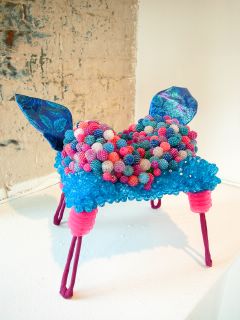 © Gae Savannah
© Gae Savannah
"Angelique" 2003; hair accessories, beads, fabric, aluminium, wood; 14” x 17” x 11” 
Taffy
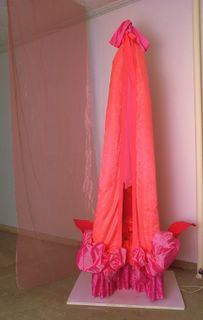
© Gae Savannah 2002 114" x 48" x 48"
Labels: click to enlarge
Taffy and Wysteria at Scene Gallery, Lower East Side, NY
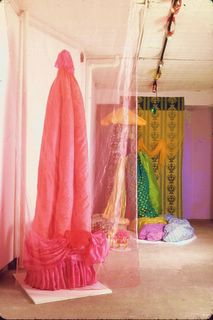 © Gae Savannah (2002)
© Gae Savannah (2002)
 © Gae Savannah"Patisserie" (6 of 20) 2002; floral, wedding, & hair accessories / beads / ornaments / garlands; approx.13” x 12” (diameter) each.
© Gae Savannah"Patisserie" (6 of 20) 2002; floral, wedding, & hair accessories / beads / ornaments / garlands; approx.13” x 12” (diameter) each. 
 © Gae Savannah"Patisserie" (3 of 20) 2002; floral, wedding, & hair accessories / beads / ornaments/ garlands; approx. 13” x 12” (diameter) each.
© Gae Savannah"Patisserie" (3 of 20) 2002; floral, wedding, & hair accessories / beads / ornaments/ garlands; approx. 13” x 12” (diameter) each. 
 © Gae Savannah"Wysteria" 2002; fabric / mesh / X’mas ornaments, copper/ light; 114” x 72” x 60”
© Gae Savannah"Wysteria" 2002; fabric / mesh / X’mas ornaments, copper/ light; 114” x 72” x 60” 
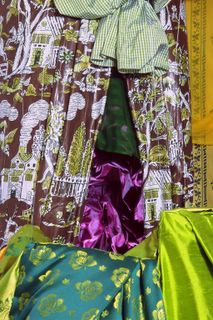 © Gae Savannah"Wysteria" detail
© Gae Savannah"Wysteria" detail
Big Igloo
 interior
interior  © Gae Savannah"Big Igloo" 2005; fabric, hair accessories, beads, ornaments, mirrors, toys, 20” x 18” diameter
© Gae Savannah"Big Igloo" 2005; fabric, hair accessories, beads, ornaments, mirrors, toys, 20” x 18” diameter
 © Gae Savannah"Khaya" 2004; fabric, hair accessories, beads, 14” x 16” x 14”
© Gae Savannah"Khaya" 2004; fabric, hair accessories, beads, 14” x 16” x 14”
 © Gae Savannah"Fatty" 2004; hair accessories, trimmings, beads, wood, 16”x 11” (diameter)
© Gae Savannah"Fatty" 2004; hair accessories, trimmings, beads, wood, 16”x 11” (diameter) 
 © Gae Savannah"Oblivion" 2004, hair accessories, aluminium, mesh, fabric, plastic; 186” x 102” x 45"
© Gae Savannah"Oblivion" 2004, hair accessories, aluminium, mesh, fabric, plastic; 186” x 102” x 45" 



















 interior
interior 
